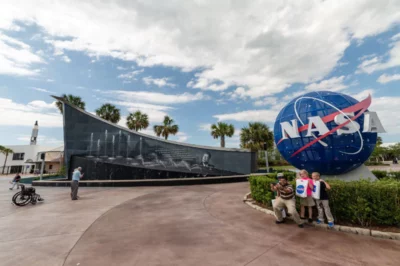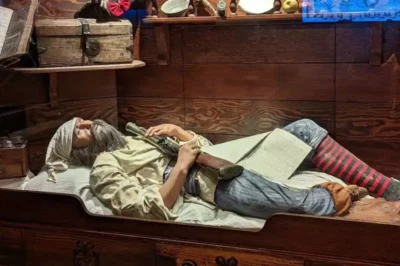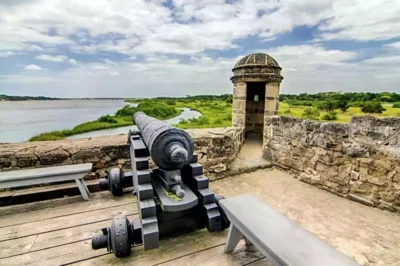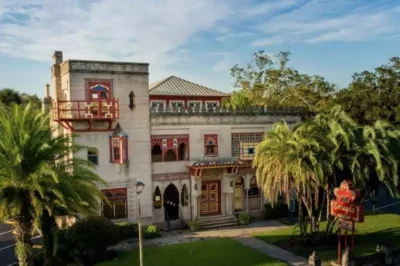- St Augustine Lighthouse History
- Architectural Features and Significance
- How many steps is the St Augustine Lighthouse?
- What lens is used in lighthouse?
- What are the 2 colors of the stripes of the St. Augustine Lighthouse?
- The Maritime Museum
- St Augustine Lighthouse Ghost Tour in Haunted Lighthouse
- Dark of the Moon tour in the Lighthouse
- How to Get to St Augustine Lighthouse and Museum?
- FAQs
- What is the history of the St. Augustine Lighthouse?
- What is the significance of the St. Augustine Lighthouse?
- Can visitors climb the St. Augustine Lighthouse?
- What can be found at the St. Augustine Lighthouse Museum?
- Are there any special tours available at the St. Augustine Lighthouse?
- What other attractions are at the St. Augustine Lighthouse site?
St Augustine Lighthouse and Maritime Museum Florida
We are in St. Augustine Lighthouse and Maritime Museum, a captivating attraction that offers a unique glimpse into the rich maritime history and cultural heritage of St. Augustine, Florida.
This iconic landmark, with its distinctive black and white spiral pattern, has guided mariners along the northeastern coast of Florida since its completion.
Adjacent to the lighthouse, the Maritime Museum showcases engaging exhibits and displays that reveal the city’s seafaring past and its impact on the community.
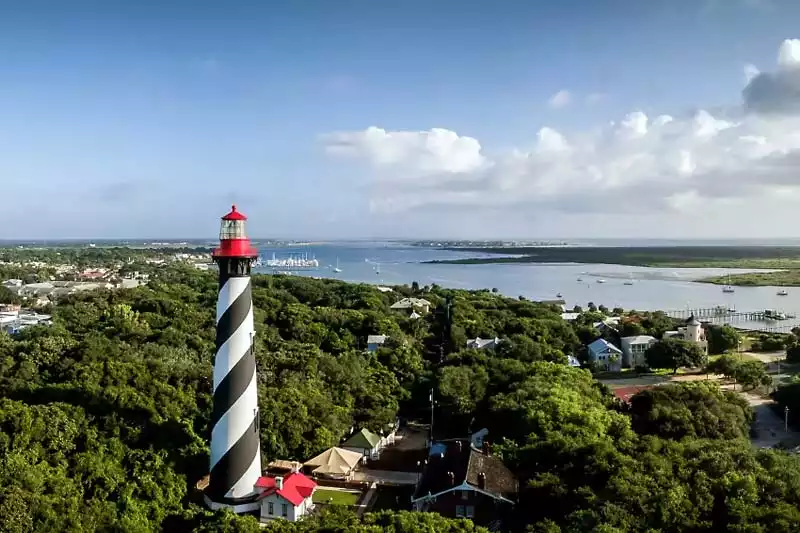
Embark on a journey through time as you climb the 219 steps to the top of the lighthouse, explore the museum’s fascinating collections, and immerse yourself in the stories of bravery, adventure, and mystery that define St. Augustine’s coastal legacy.
St Augustine Lighthouse History
The history of the St. Augustine Lighthouse can be traced back to the late 16th century when a wooden watchtower was built by the Spanish settlers on the coastline of St. Augustine. This watchtower served as an early navigational aid, helping mariners identify the entrance to the city’s harbor.
In 1824, the United States government recognized the importance of a permanent navigational aid in the area and constructed a new lighthouse tower on the site of the original wooden watchtower.
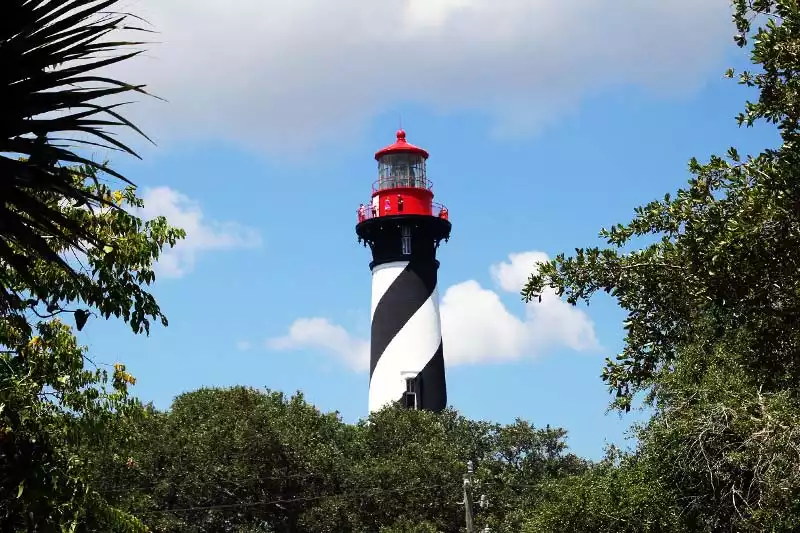
This structure was made of coquina, a locally sourced limestone. However, due to beach erosion and a receding shoreline, it became evident that this lighthouse would not withstand the test of time.
Recognizing the need for a more durable and modern lighthouse, the U.S. government commissioned the construction of the current St. Augustine Lighthouse in 1871. The new tower was designed to be taller, more robust, and equipped with a state-of-the-art Fresnel lens, providing greater visibility for mariners.
The construction process involved sourcing high-quality bricks from Alabama, which were then transported to St. Augustine by ship. Skilled masons and craftsmen were employed to ensure the lighthouse’s longevity and effectiveness. The St. Augustine Lighthouse was finally completed in 1874 and has since served as an essential beacon for maritime navigation along Florida’s northeastern coast.
Architectural Features and Significance
The St. Augustine Lighthouse is an impressive architectural structure, standing at 165 feet tall. It is one of the tallest lighthouses in Florida, providing a commanding view of the surrounding coastline. The current lighthouse tower is a testament to historical engineering and maritime significance.
How many steps is the St Augustine Lighthouse?
The tower consists of 219 steps, which visitors can climb to reach the observation deck and witness a panoramic vista of the city and the Atlantic Ocean.
What lens is used in lighthouse?
The lighthouse is equipped with a first-order Fresnel lens, a highly advanced optical system for its time. This lens allows the lighthouse’s beam to be visible from up to 24 nautical miles away, guiding mariners and ensuring safe navigation along the coast.
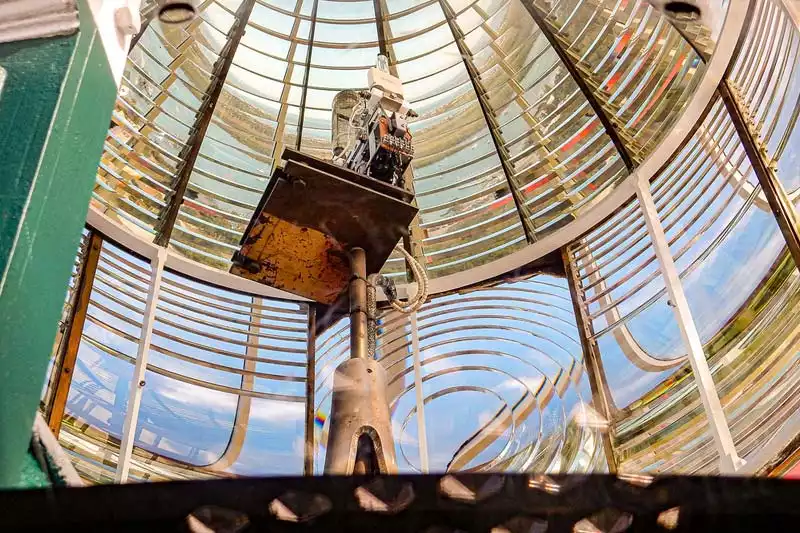
The combination of its height, powerful lens, and strategic location makes the St. Augustine Lighthouse an essential navigational aid for ships entering and leaving the city’s harbor.
What are the 2 colors of the stripes of the St. Augustine Lighthouse?
One of the most striking features of the St. Augustine Lighthouse is its distinctive black and white spiral pattern, also known as a barber pole design. This unique pattern serves a practical purpose, as it increases the visibility of the lighthouse during daylight hours, making it easily identifiable for mariners approaching the coast.
Climbing the Lighthouse
Climbing the St. Augustine Lighthouse is an unforgettable experience for visitors. With 219 steps leading to the top, the ascent offers a unique opportunity to learn about the lighthouse’s history, construction, and the daily life of its keepers. Interpretive panels along the climb provide interesting facts and stories that add depth to the visitor experience.
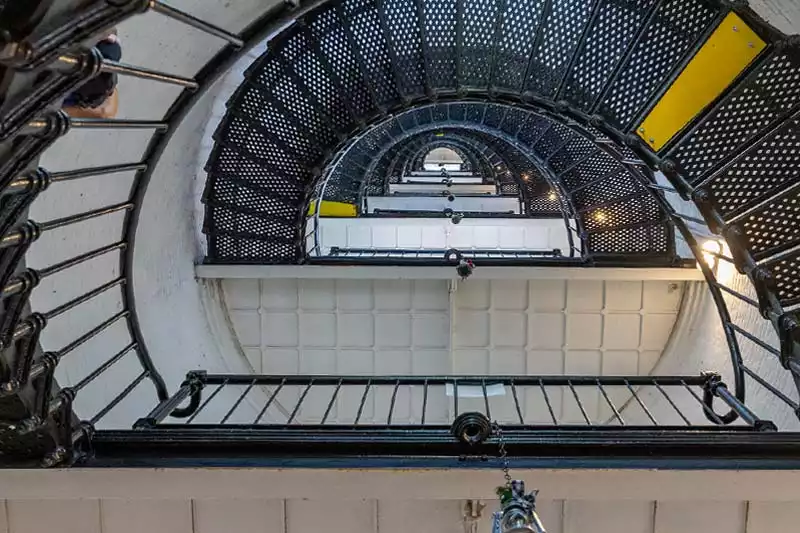
Upon reaching the observation deck, visitors are rewarded with a breathtaking panoramic view of St. Augustine, its historic harbor, and the Atlantic Ocean. The stunning vista allows guests to truly appreciate the lighthouse’s strategic location and its role in maritime navigation.
Safety Measures
The St. Augustine Lighthouse is committed to ensuring a safe and enjoyable experience for all visitors. The tower’s steps are equipped with handrails to assist climbers, and there are several landings throughout the ascent where guests can pause to rest and enjoy the historical exhibits.
However, it is important to note that the lighthouse’s historic nature means it is not fully accessible to individuals with mobility limitations. Visitors should be in good physical condition and able to climb a significant number of steps.
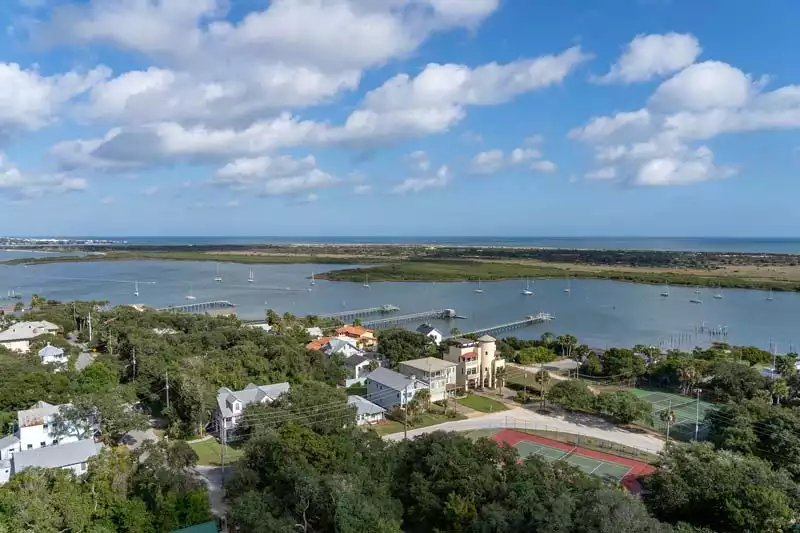
For the safety and comfort of all guests, the lighthouse staff monitor weather conditions and may close the tower to climbing during storms or high winds. Additionally, capacity limits may be enforced to prevent overcrowding on the observation deck.
The Maritime Museum
Nestled alongside the iconic lighthouse, the St. Augustine Maritime Museum warmly welcomes visitors to explore and celebrate the rich maritime history of St. Augustine and its surrounding areas.
With a heartfelt dedication to education, the museum’s purpose is to enlighten guests about the significance of lighthouses, maritime heritage, and the sea’s vital role in shaping the region’s development.
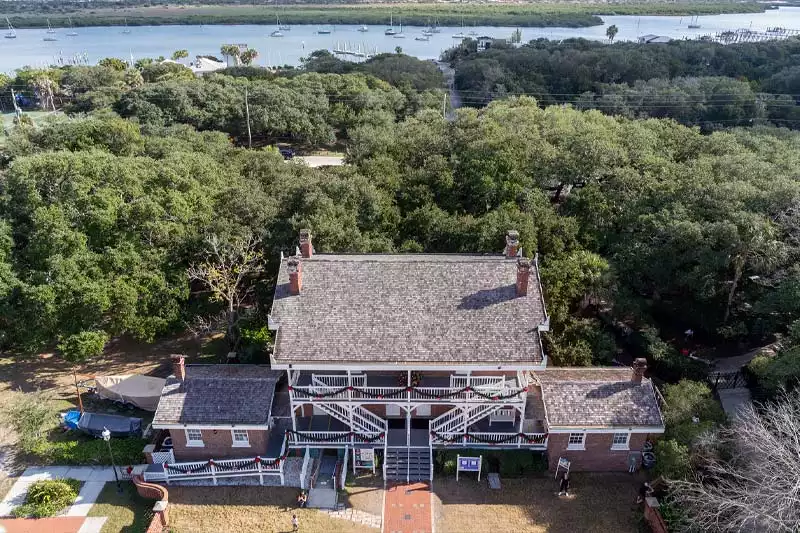
As you step into the Maritime Museum, you’ll be greeted by a diverse array of exhibits and displays that offer an intriguing window into St. Augustine’s seafaring past. Among the many captivating exhibits, you’ll discover:
- Shipwreck artifacts and underwater archaeology: The museum houses a collection of artifacts recovered from shipwrecks off the coast of St. Augustine, showcasing the city’s long and sometimes perilous relationship with the sea. Visitors can learn about underwater archaeology techniques used to uncover these treasures and the stories they tell about life at sea in different time periods.
- Maritime history and the role of the sea in St. Augustine’s development: Through interactive exhibits and engaging displays, the museum explores the history of St. Augustine’s maritime industry, from its earliest days as a Spanish settlement to its role as a bustling seaport during the 19th and 20th centuries. Visitors can discover how the city’s location on the Atlantic coast influenced its growth, trade, and cultural exchanges.
- Daily life of lighthouse keepers and their families: The museum offers a unique insight into the lives of lighthouse keepers and their families who lived and worked at the St. Augustine Lighthouse. Exhibits include personal artifacts, photographs, and letters, providing an intimate glimpse into the daily routines, challenges, and triumphs experienced by these dedicated individuals.
- Fresnel lens exhibit: The museum features a display dedicated to the history and technology of the Fresnel lens, which revolutionized lighthouse illumination during the 19th century. Visitors can learn about the intricate design and craftsmanship of these lenses and their crucial role in maritime navigation.
St Augustine Lighthouse Ghost Tour in Haunted Lighthouse
The St. Augustine Lighthouse has a long history of ghost stories and paranormal encounters, capturing the imagination of visitors and locals alike. Many believe that the spirits of former lighthouse keepers, their families, and shipwreck victims still linger within the tower and surrounding grounds.
One of the most famous ghost stories involves the tragic deaths of two young girls who were playing on a construction cart during the building of the current lighthouse in the early 1870s. It is said that their spirits can still be seen playing around the lighthouse grounds.
Additionally, visitors and staff have reported witnessing the apparition of a lighthouse keeper, believed to be the spirit of Joseph Andreu, who tragically fell to his death while painting the tower.
These ghost stories and paranormal encounters have made the St. Augustine Lighthouse a popular destination for ghost tours and paranormal investigations, adding a layer of intrigue and mystery to its rich history.
Dark of the Moon tour in the Lighthouse
The Dark of the Moon tour is a popular and thrilling experience offered at the St. Augustine Lighthouse and Maritime Museum. This unique after-hours guided tour invites guests to explore the historic lighthouse and grounds while delving into the eerie ghost stories and paranormal encounters that have been reported at the site over the years.
During the tour, knowledgeable guides share spine-chilling tales of tragedy, mysterious happenings, and unexplained phenomena, all while leading visitors through the lighthouse, the Keeper’s House, and the surrounding property.
Participants are provided with special ghost-hunting equipment, such as EMF meters and flashlights, to aid in their quest to uncover the supernatural secrets that lurk in the shadows of the St. Augustine Lighthouse.
The Dark of the Moon tour is a unique opportunity for history enthusiasts, paranormal investigators, or those simply seeking an exciting and spooky adventure. The tour’s combination of fascinating stories, historic locations, and the chance to explore the lighthouse after dark creates an unforgettable experience that’s not to be missed.
Please note that the Dark of the Moon tour may not be suitable for young children or individuals who are sensitive to paranormal themes. It is recommended to check the lighthouse’s website or contact their visitor center for information on tour schedules, age restrictions, and ticket prices.
How to Get to St Augustine Lighthouse and Museum?
To get to the lighthouse and museum, follow these directions depending on your starting point and mode of transportation:
- By car
To reach here from the Lion Bridge in the city center by car, follow these directions:
Start at the Lion Bridge (Bridge of Lions) in downtown St. Augustine, and head east across the bridge onto Anastasia Island. Continue straight as the road becomes A1A South/Anastasia Blvd. Drive for approximately 1.2 miles on A1A South/Anastasia Blvd. Turn right onto Red Cox Dr. After about 0.6 miles, you’ll see the entrance to the lighthouse on your right.
The total distance is approximately 2.5 miles, and the drive should take around 10 minutes, depending on traffic conditions.
There is a parking lot available for visitors. The parking lot is located on the museum grounds, just a short walk from the lighthouse and museum entrance.
- By public transportation
While public transportation options in St. Augustine are limited, the Sunshine Bus Company operates several routes in the city. You can take the Red or Purple line, which stops near the lighthouse and museum.
- On foot or by bike
If you’re staying in downtown St. Augustine, the lighthouse is approximately 2.5 miles away. You can walk or bike to the site by heading south on Avenida Menendez, which becomes Anastasia Blvd (A1A South) as you cross the Bridge of Lions.
Address: The St. Augustine Lighthouse and Maritime Museum is located at 100 Red Cox Dr, St. Augustine, FL 32080. Use this address for GPS navigation or online mapping services.
FAQs
What is the history of the St. Augustine Lighthouse?
The St. Augustine Lighthouse, Florida’s first lighthouse, has a rich history dating back to the late 1500s when the Spanish built a wooden watchtower. The current lighthouse, built from 1871-1874, stands on the site of Florida’s first lighthouse, recognized on the national register of historic places.
What is the significance of the St. Augustine Lighthouse?
This iconic lighthouse serves as an active aid to navigation, a symbol of maritime heritage, and a testament to historic preservation. It’s part of a maritime program that includes maritime archaeology and artifact conservation, emphasizing the nation’s oldest port’s history.
Can visitors climb the St. Augustine Lighthouse?
Yes, visitors can climb 219 steps to the top of the lighthouse for panoramic views of St. Augustine and the Atlantic Ocean. This climb is a highlight of the tour, offering a unique perspective of the area’s natural and historical beauty.
What can be found at the St. Augustine Lighthouse Museum?
The museum showcases maritime history, the life of a lighthouse keeper, and ongoing preservation efforts. It includes exhibits on maritime archaeology, traditional wooden boatbuilding, and daily programs for an enriching educational experience.
Are there any special tours available at the St. Augustine Lighthouse?
Yes, there are unique tours like the ghost hunters’ tour and the Dark of the Moon tour, which explore the haunted aspects of the lighthouse. These tours offer an intriguing glimpse into the lighthouse’s mysterious past.
What other attractions are at the St. Augustine Lighthouse site?
The site includes nature trails, a gift shop, and the lighthouse keeper’s house. The grounds also host educational programs and activities, making it an ideal spot for learning about maritime history and coastal ecology.
Conclusion
In conclusion, the lighthouse and museum are must-visit attractions for anyone interested in history, maritime culture, or stunning panoramic views. The lighthouse’s iconic design, intriguing ghost stories, and tales of heroism showcase the rich and diverse history of St. Augustine.
The Maritime Museum complements the lighthouse experience by preserving and presenting the city’s maritime heritage through engaging exhibits and displays.
